Business of PHC, Part 6: Diagnostics Is a Critical Component of Plant Health Care
Diagnosing the cause of plant problems is one of the foundational components of all plant-health-care programs. Without knowing the fundamental cause of a plant’s problem, it is highly unlikely that a successful remediation strategy can be designed and implemented. Environmental factors of the non-living world – abiotic factors – and those of the living world – biotic factors – can work independently or in concert with each other to affect the appearance, growth, development and survival of plants in landscapes.
Abiotic factors include a variety of environmental stressors broadly categorized as physical and chemical factors (Antonelli at al. 2009). Physical factors include soil compaction and composition, drought, flooding, exposure to extremes of solar radiation and temperature and mechanical injury to plants. Chemical factors impacting plants include concentrations of minerals and ions (pH) in soil, soil salinity and airborne and soilborne pollutants, including pesticides.
Biotic factors affecting plants include competition with other plants in the landscape; allelopathic interactions (one plant inhibiting the growth of another, usually by chemicals released in the environment); and herbivory (feeding on plants) caused by insects, mites, mollusks (snails, slugs) and small and large mammals such as rodents, squirrels and deer. In addition to these plant eaters, a variety of microbes, including viruses, bacteria, phytoplasmas and nematodes, cause injury to plants.
Plant-health-care practitioners use a systematic approach, a process, to diagnose plant problems and to develop and implement remediation tactics and strategies. Excellent step-by-step guides for diagnosing problems of landscape plants are available (Antonelli et al. 2009, Boggs et al. 2021). Most diagnostic schemes share these common steps.
1. Identify the plant
Why is plant identification so important? Although some pests, such as Japanese beetle and gypsy moth, are super generalists, feeding on hundreds of species of plants, many insects and mites are specialists, feeding on a limited number of plants. Often, host selection takes place at the level of plant family or genus. This can be extremely useful in narrowing the search for a specific perpetrator of plant injury.
Business of PHC Series at a Glance
This is the third article in a planned 12-part series called Business of PHC that will run in TCI over the next year, focusing on what a smaller company needs to know to launch a plant-health-care program and start offering PHC services. The various aspects of this lucrative profit center that we have covered or plan to cover include:
- “PHC – It Could Be the Shot in the Arm Your Company Needs” [TCI, April 2021]
- “Elements of a Plant-Health-Care Business Plan” [TCI, May 2021]
- “How to Equip Your Business Without Breaking the Bank” [TCI, June 2021]
- What people will you need? [TCI, July 2021]
- The science: Host species and the things that affect them. Get to know the trees in your area and their problems. Understand treatment selection. [TCI, August 2021]
- Diagnosing pest/abiotic problems
- Simple soil science/use of soil amendments [Scheduled for October]
- Structural pruning [Scheduled for November]
- Licensing and regulatory requirements [Scheduled for December]
- Marketing/selling PHC contracts [Scheduled for January 2022]
- Scheduling/fulfilling PHC contracts [Scheduled for February 2022]
- PHC resources – TCIA PHC Technician, soil-testing labs, pest-diagnostic services, etc. [Scheduled for March 2022]
For example, suppose you see a planting of trees with dieback in the canopy. (Photo 1) Clearly, abiotic stressors like restricted root zones and volcano mulch appear to be factors contributing to dieback, but are biotic factors involved as well? By identifying the trees as green ash and coupling the symptom of dieback, you begin to construct a list of potential biotic agents causing this symptom. On the pathogen side, the phytoplasma causing ash yellows might be the culprit, and on the insect side, emerald ash borer, lilac/ash clearwing borer and banded ash clearwing borer specialize on plants in the olive family and are commonly found in the genus Fraxinus, ash trees. Observing dieback in the canopy of a tree and knowing the tree is an ash immediately reduces the number of potential pathogens and insects that might cause dieback.
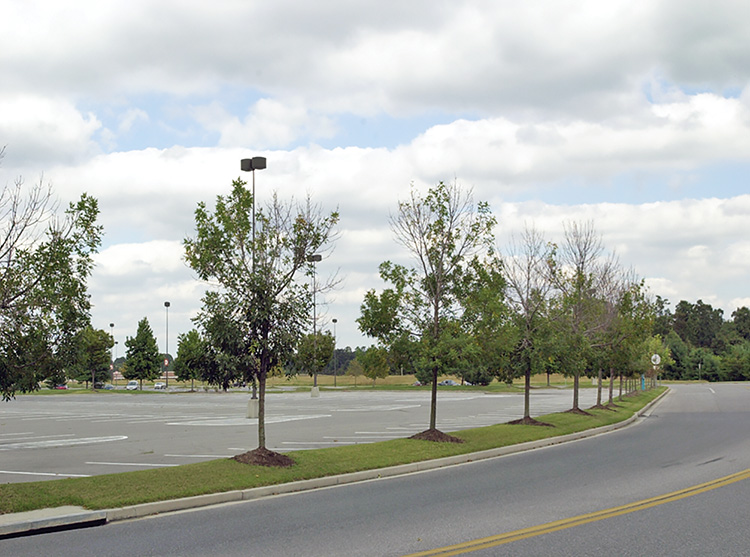
Another very practical reason to fully identify the taxonomic identity of a plant lies in the fact that most books, fact sheets, bulletins and online identification tools will be indexed by the genus, species or common name of the plant under attack. Correctly identifying the plant in question is the critical first step in a diagnosis. As you conduct your online searches, be cautious in using common names. As pointed out by Boggs et al. (2021), common names can be misleading. For example, in the United States, a lime tree is a member of the genus Citrus that produces an edible green fruit. In the United Kingdom, lindens (Tilia), go by the common name of lime tree.
2. Is what you see normal or abnormal?
Successful PHC technicians must be familiar with attributes of the client’s plants for which they care. These attributes include normal color, size and shape of buds, leaves, flowers, fruit, bark, canopy, trunk and roots.
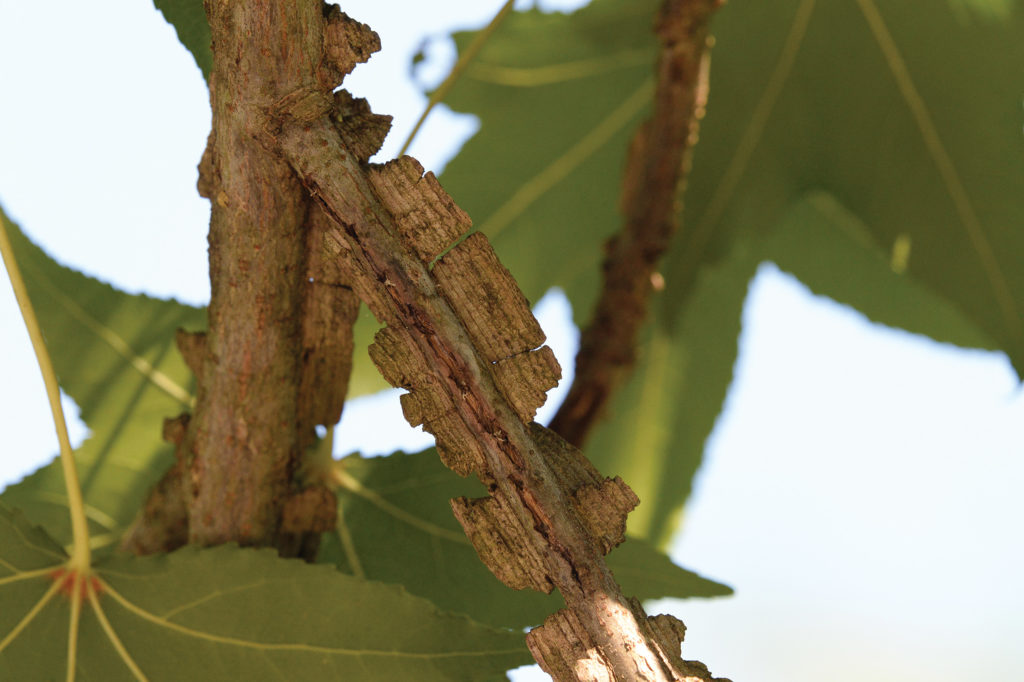
Clients sometimes express concern when deciduous, narrow-leaved gymnosperms such as larch (Larix) and dawn redwoods (Metasequoia) drop their needles in autumn, or when pines (Pinus) shed their needles in fall. Corky bark flanges on branches of sweetgum (Liquidamber) sometimes result in a misdiagnosis of a bark abnormality. (Photo 2) Variegated cultivars of trees and shrubs might be misdiagnosed as victims of a viral infection or nutrient deficiencies due to their unusual color patterns, unless technicians are familiar with potential varietal variations. (Photo 3)
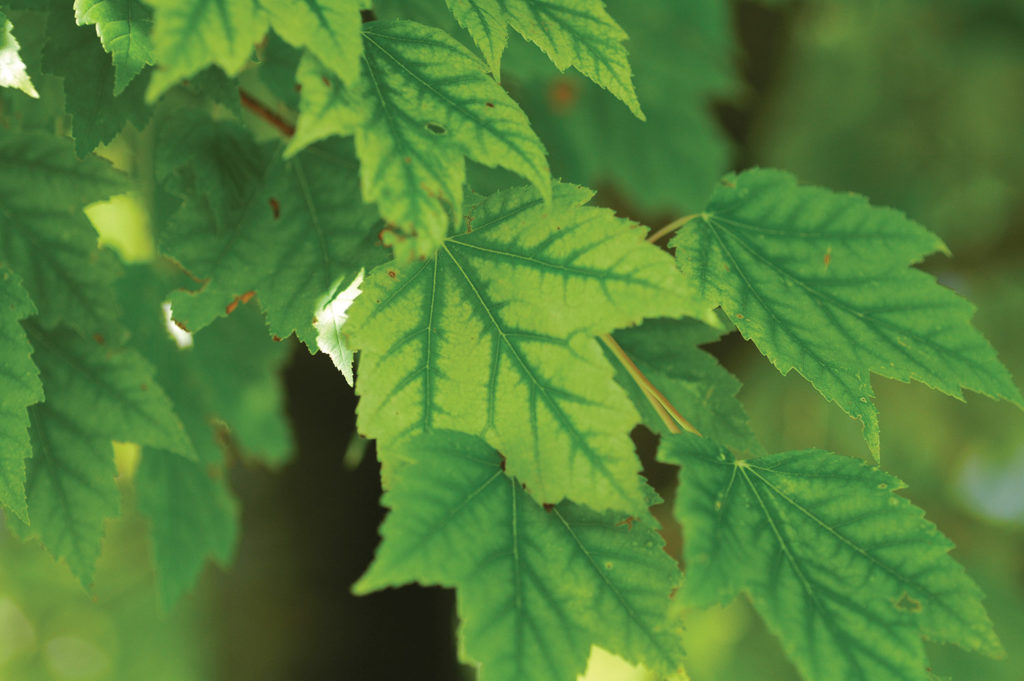
Above-ground features of bark are useful in diagnosis. Gray-brown is the normal bark color of sugar maple (Acer saccharum). Black bark commonly seen on sugar maples is abnormal, and is a good clue of an infestation of aphids or soft scales that produce honeydew and support the growth of sooty mold on the bark. (Photo 4)
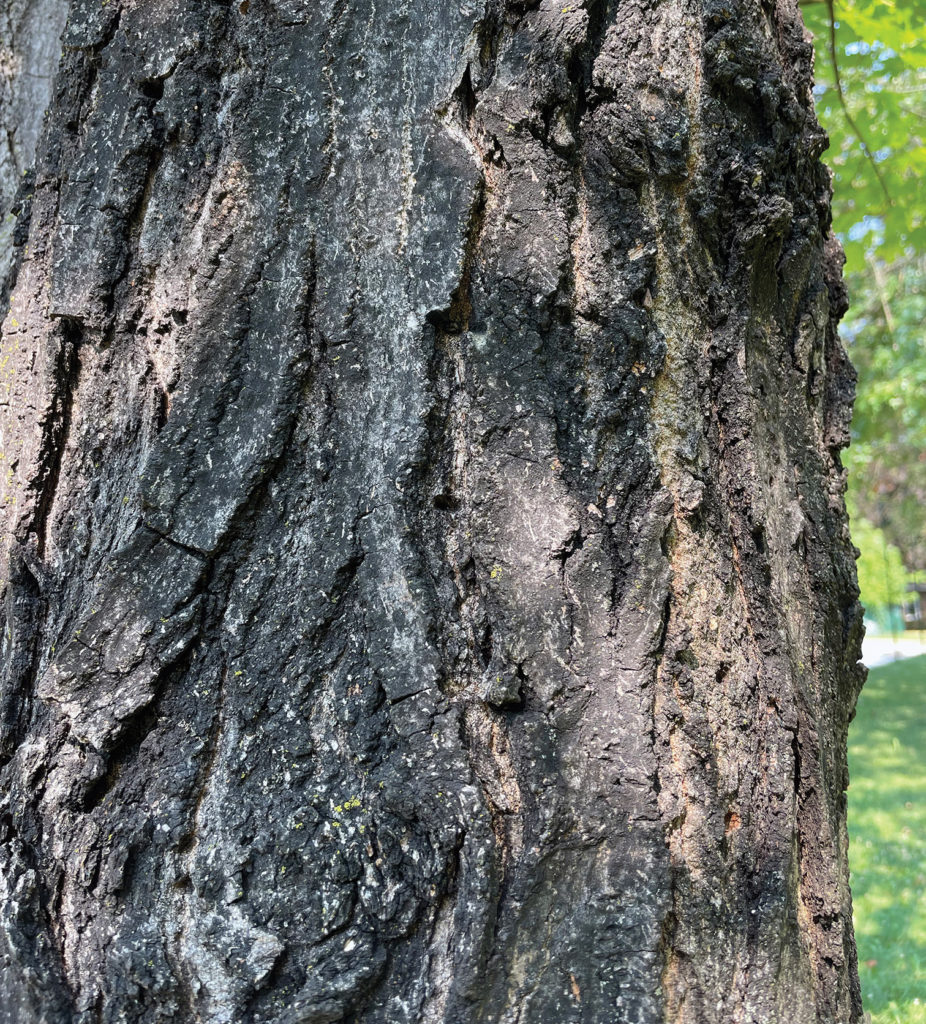
Growth patterns of entire plants and parts of plants provide important diagnostic clues. Symmetry, shape and density of a tree’s canopy are attributes useful in assessing abnormalities. Trunks of normal trees are usually straight, uniform and circular, while bent trunks and flattened or sunken areas on trunks may be abnormal and indicative of damage to roots or underlying vascular tissues. (Photo 5) Growth patterns of branches, such as the incremental distance between bud scars that marks the annual growth of branches, provide a historical record to determine if growth is uniform or increasing or decreasing through time, and often provide evidence of chronic plant stress.
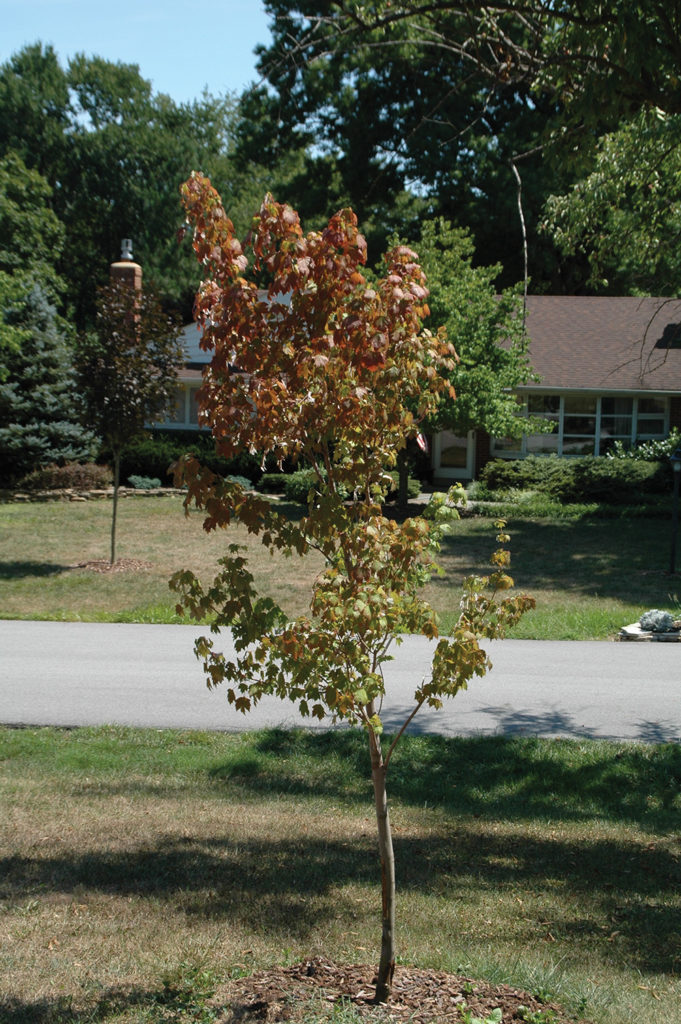
Below-ground features, such as normal and abnormal colors and patterns of roots, can help in diagnosis. Healthy tree roots will be firm, bright and light colored beneath the bark, while unhealthy roots will be flaccid and dark in color.
3. Use symptoms and signs to narrow the causes of the problem
PHC practitioners may be familiar with the terms “symptoms” and “signs,” and some use these terms interchangeably. However, symptoms and signs are not the same. Symptoms are how organisms, such as trees and shrubs, respond to abiotic or biotic stressors, like drought that results in wilting of Rhododendron or a soil-borne vascular pathogen like Phytophthora that also may cause wilting in Rhododendron. Symptoms can be non-specific and may have many causes.
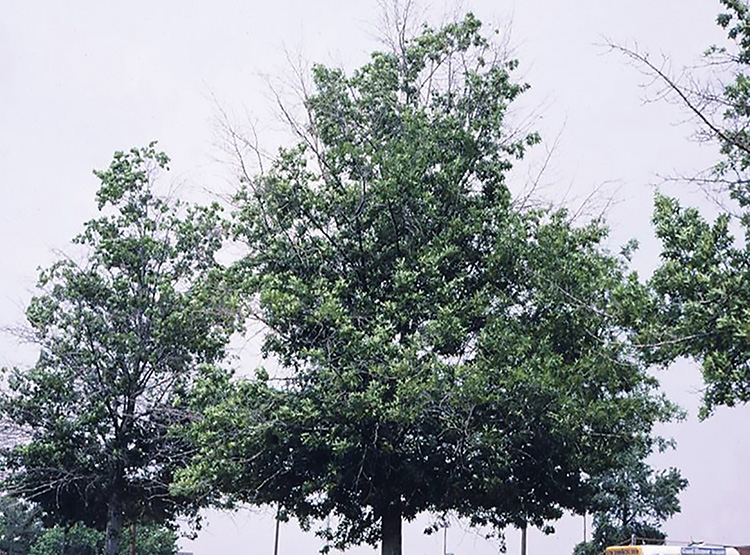
Take, for example, dieback in the canopy of pin oak trees (Photo 6) in a parking lot. Dieback is a symptom, but many agents could be at work singly or in concert to create dieback. Perhaps roots of the tree are buried under several inches of volcano mulch. Perhaps a plastic chord (Photo 7) was not removed from a root ball when the tree was installed. Maybe weed whackers debarked the tree at the root flares. Perhaps the tree has a pathogen, such as bacterial leaf scorch, or a heavy infestation of armored scale insects. Each of these agents could result in the outward symptom of dieback. To pin down the true agent or agents underlying the symptom of dieback, we have to dig a little deeper, and this is where signs come into play.
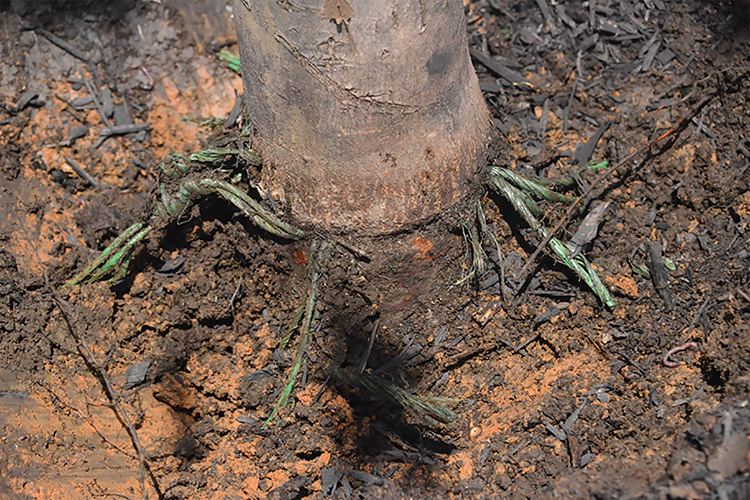
Signs are quite definitive and can include the organism itself or direct products or features left behind by the organism. Signs of fungal infections include fungal hyphae or fruiting bodies like the strange, gelatinous, orange fruiting bodies of cedar-apple rust seen on junipers (Photo 8), or the chocolate stains lining vascular elements of elms infected with Dutch elm disease. Signs of attack by insects include adults, eggs, nymphs, larvae, pupae, cocoons and shed skins of insects or mites.
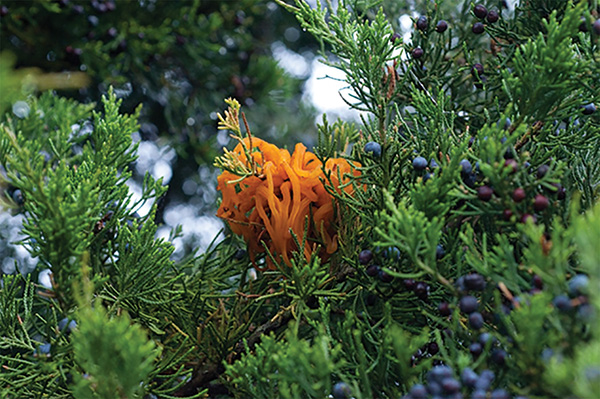
Signs also can include specific, easily recognized objects or other clues left behind by an insect or mite. Silk is produced by caterpillars, sawfly larvae and spider mites. Frass, a polite term for pellets and sawdust-like tailings of insect excrement, is produced by boring larvae and adults of beetles, larval sawflies and caterpillars. Wax coverings, solid or fluffy, are the hallmark of sucking insects like scales, whiteflies, mealybugs and their kin. Exit holes in bark also can serve as signs. In the aforementioned example of dieback on a pin oak tree, the signs of a pest, such as waxy incrustations of obscure scale (Photo 9), help identify a key causal agent of dieback. Root zones restricted by pavement and compacted soils due to foot traffic beneath trees also conspired to cause dieback in the canopy of this pin oak tree.
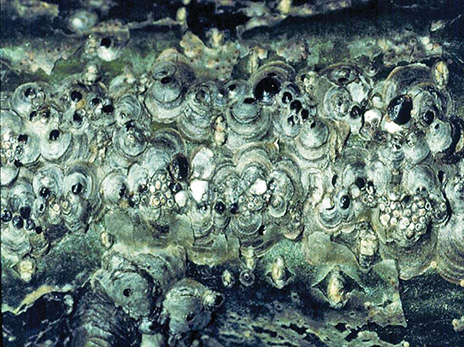
Traditionally, diagnoses relied on visual inspections of plants and the associated symptoms and signs. In many cases, a definitive diagnosis requires collecting above- and below-ground tissue samples from the affected plant and conducting microscopic examinations or, more recently, molecular analyses capable of detecting the DNA of a pest or a protein associated with the pest in plant tissue. Molecular kits for detecting plant pathogens are readily available and widely used by independent and arborist-owned diagnostic testing labs. In addition to samples of plant tissue, soil samples are especially important in diagnosing soil-related problems linked to abiotic factors such as mineral deficiencies or excesses, pH levels and soil microbes.
4. Observe the pattern of damage on the focal plant and also on surrounding plants of the same and different species
Investigating symptoms on a single leaf or branch is not always sufficient in making an accurate diagnosis. Taking a larger view of the situation can reveal the causal agent or agents contributing to a problem. Many biotic stressors like insects, mites or pathogens produce symptoms in non-uniform patterns on individual parts of plants or individual plants in a mixed-species planting. In other words, injury may be scattered in patches in the canopy of a tree rather than encompassing the entirety of branches. This is especially true in the early stages of an insect infestation or a pathogen infection.
Symptoms caused by biotic factors often become more widespread or severe with time. Consider a large green wall of Leyland cypress in a residential landscape. Initial infestations of bagworms begin when one or a few females colonize a tree. (Photo 10) Defoliation will be localized on just a few branches of one tree in the first year, and, if detected and diagnosed correctly, therapy will be cheap and easy. Over time, the entire canopy of the tree may be infested and the infestation can spread to other trees, adding to the cost of the intervention.
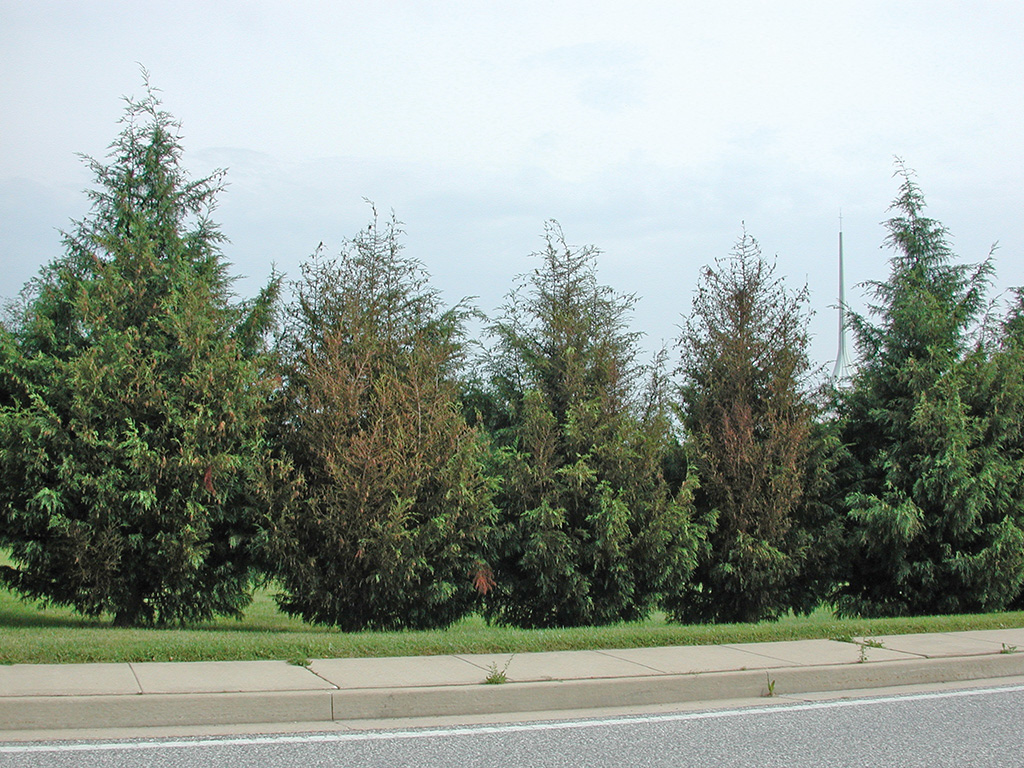
By contrast, abiotic factors often cause uniform damage patterns on a single tree, group of the same tree species or mixed-species plantings. Extreme temperatures, such as a late frost, may cause uniform blossom injury to an entire single- or mixed-species planting of cold-sensitive plants such as camelias and magnolias.
Of course, some abiotic factors such as soil pH, salinity, improper installation and culture or mechanical injury are not uniformly distributed in space. In parking lots and sidewalks, where snowplows and shovels deposit salt-laden piles of snow, ground covers such as junipers may be discolored, while in beds nearby where snow is not deposited, junipers may be completely normal in appearance. (Photo 11)
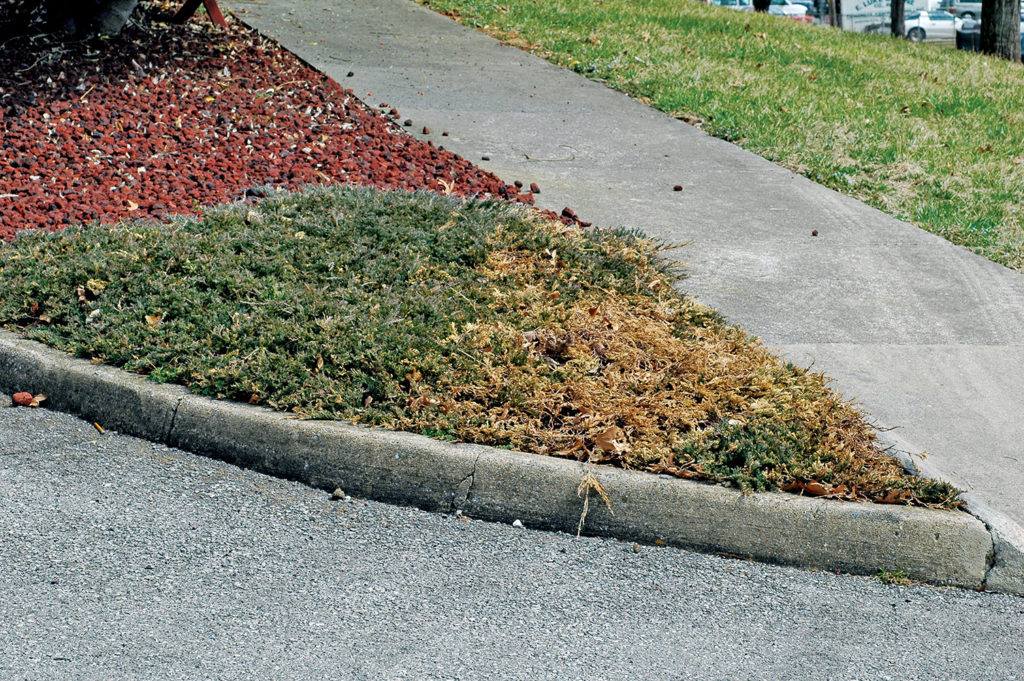
Similar non-uniform patterns of abiotic disorders result when weed whackers debark trees, incorrect drainage creates water-logged soils which become anaerobic, construction equipment severs roots or compacts soils, plants are installed too deeply or mulch is incorrectly applied and maintained. (Photo 12)
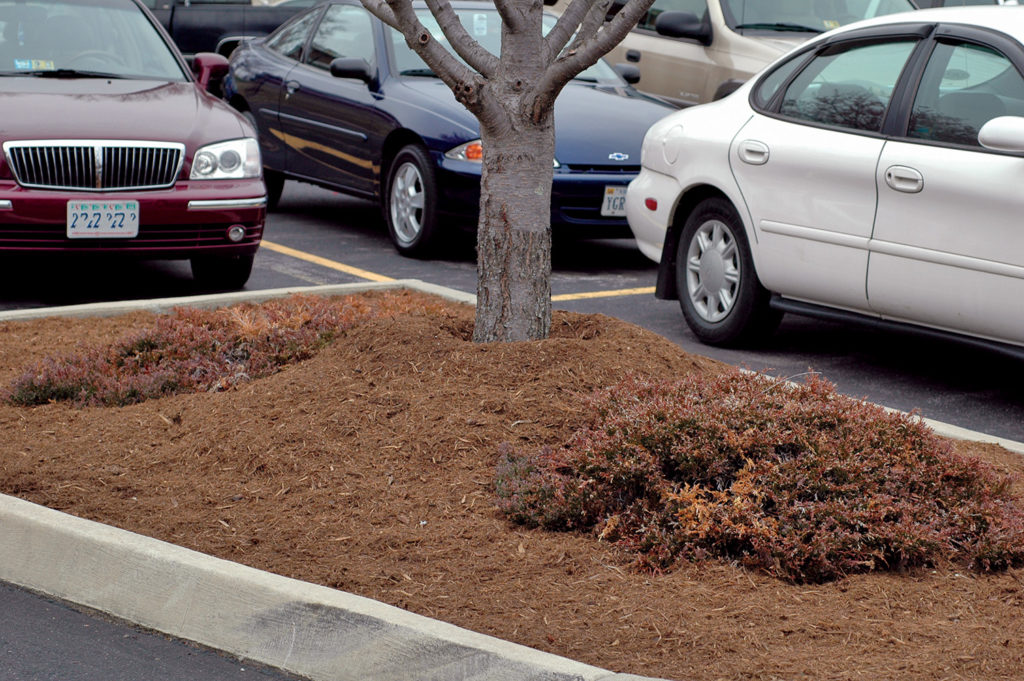
5. Learn how the damage occurred and how the planting site has changed
Boggs et al. (2021) aptly points out that conversations with the clients or providers of landscape-maintenance services may provide important and useful insights into the progression of symptoms on damaged plants. Understanding the history of the landscape site is vital, especially in the case of chronic problems. Companies interested in developing and refining PHC programs should endeavor to compile the present and past history of several factors affecting landscapes under their care.
When possible, this information includes: the genus, species and location of earlier plantings removed because of poor performance; amendments to improve water retention, permeability or infiltration; aeration or structure of soil; fertilizer applications; pH adjustments; applications of insecticides, miticides, fungicides and herbicides; unusual winter or summer temperatures; floods or droughts; changes in grade and drainage problems; and irrigation and patterns of water use.
Conclusion
Diagnosing plant problems is a process undertaken by well-trained technicians. To increase the likelihood of successful diagnoses of plant problems, technicians must have knowledge, skills and inquisitive behaviors. First, a solid level of technical competence is key. The knowledge base should include a solid ability to identify landscape plants and a fundamental understanding of plant culture, including the abiotic and biotic causes of plant injury. Second, diagnosticians will have keen observational skills and be able to differentiate between what is normal plant appearance and growth and what is abnormal. Finally, diagnosticians must have a sense of curiosity and a hunger to learn not only the types of plant injury, but also their underlying causes (Davidson and Raupp 2009).
Literature cited
Boggs, Joe, Erik Draper, Jim Chatfield, Sarah D. Williams and Mike J. Boehm. 2021. 20 Questions on Plant Diagnosis. Ohio State University Extension. Accessed July 20, 2021. https://ohioline.osu.edu/factsheet/plpath-gen-3
Antonelli, Art, Linda Chalker-Scott, Carrie Foss and Jenny Glass. 2009. Diagnosing Plant Stress: Living and Non-living Causes. In: Sustainable Landscapes and Gardens: good science – practical application. Linda Chalker-Scott, Editor. Washington State University.
Davidson, John and Michael Raupp. 2014. Managing Insects and Mites on Woody Plants: An IPM Approach. Tree Care Industry Association, Inc.
Other references useful in diagnosing plant problems
Costello, Laurence. 2014. Abiotic Disorders of Landscape Plants: A Diagnostic Guide. University of California Agriculture and Natural Resources.
Dreistadt, Steve. 2016. Pests of Landscape Trees and Shrubs: An Integrated Pest Management Guide. University of California Agriculture and Natural Resources.
Johnson, Warren and Howard Lyon. 1988. Insects that Feed on Trees and Shrubs. Cornell University Press.
Luley, Christopher and Ad Ali. 2009. Pest Management in the Landscape: An Introduction (Visual Identification). Urban Forestry.
Miller, Douglas and John Davidson. 2006. Armored Scale Insect Pests of Trees and Shrubs (Hemiptera: Diaspididae). Cornell University Press.
Raupp, M. J. 2020. CSI for Bugs, Part 1.
Basics for diagnosing problems caused by insects and mites. Tree Care Industry Magazine. 31(11): 54-61.
Raupp, M. J. 2021. CSI for Bugs, Part 2. Diagnosing Injury Caused by Insects with Chewing Mouthparts. Tree Care Industry Magazine. 32(2): 44-50.
Raupp, M. J. 2021. CSI for Bugs, Part 3. Diagnosing Dieback Caused by Insects. Tree Care Industry Magazine. 32(3): 52-58.
Raupp, M. J. 2021. CSI for Bugs, Part 4. Diagnosing Discoloration and Distortion Caused by Insects and Mites. Tree Care Industry Magazine. 32(4): 54-61.
Raupp, M. J. 2021. CSI for Bugs, Part 5. Insect Products Provide Clues. Tree Care Industry Magazine. 32(6): 55-62.
Sinclair, Wayne and Howard Lyon. 2005. Diseases of Trees and Shrubs Hardcover. Cornell University Press.
Michael J. Raupp, Ph.D., is professor emeritus in the Department of Entomology at the University of Maryland, College Park, Maryland. He has published many articles, made numerous presentations and frequently appears on television and radio. His most recent book, 26 Things that Bug Me, published by ISA, introduces youngsters to the wonders of insects and natural history, while Managing Insects and Mites on Woody Landscape Plants, published by the Tree Care Industry Association, is a standard for the arboricultural industry. His websites include www.bugoftheweek.com and www.youtube.com/user/BugOfTheWeek.




